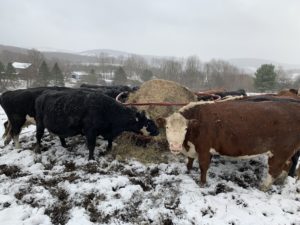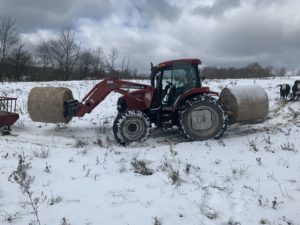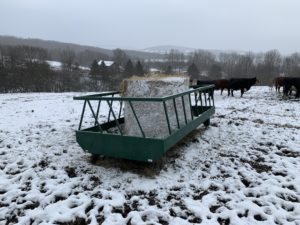Do the Math for Winter Feed Preparation
In part five of our “What’s Your Beef?” series on raising cattle on small farms, we look at how much hay you need to plan for winter feeding your beef herd.
When you receive this edition of the Small Farm Quarterly in July, we will be in the throes of the summertime grazing season. It will be warm, sunny, and life for our grazing cows will be beautiful. Watching beef calves scampering around the pastures, nursing their mothers with full udders of grass grown milk is a beautiful thing, but all good things eventually come to an end, and winter looms upon us, and the grazing season will end. There are innumerable sources of information available on the management of grazing lands for beef cattle. So rather than delving into this topic I thought it would be good for newer beef producers to be given some advice on preparing for the winter. As mentioned, grazing seasons end sooner or later, in the late autumn, typically in late October or early November. In our harsh northeastern winters, we can easily have around 7 months of having to feed stored forages. November, into May. Depending on your local climate, you may have to only feed for between 5 and 6 months and rely on grazing for the other months.
I know that there are those out there who will tell you to “kick the hay habit”. The premise in that thought process is that cows can dig through a little snow for stockpiled pasture. In areas of just a little snow accumulation, or mostly dusty, powdery snow, this might work. However, such advice is not too relevant in our normally snowy, cold northeastern winters. Deep snow, ice, slush, bitter cold winds blowing in from the northwest, mud, and continuously changing conditions; from November into May is our life in much of the Northeast. “Kick the hay habit”? Ah, OK. Cows are not going to paw their way through frozen slush and deep, crusted snow, or at least enough to thrive and nourish their fetal calves. We are going to have to feed hay, and a good bit of it, and of good quality to boot. Hay costs make up the biggest costs for maintaining a herd of beef cows.
Whether you make your own hay, or purchase it, it is relatively expensive. (see a previous article of mine in SFQ, “Hay You, Should I make my Hay or Buy it”). Additionally, in the springtime, the month of May seems to take forever to come around, and when it does, it’s still cold, rainy, with little grass to graze until well into the month in many locations. Where I live, in the cold, high elevation area of southern Madison County, we often forget that the springtime can come around! We oftentimes have snow, wind, and below freezing temps well into mid-May! Then, as if by magic, the grass grows, and it gets warm, the grass starts growing, and we can now graze. Another consideration to think about is that sometimes during the summer, we can be in a drought situation, and it may be imperative to supplement our parched pastures with some stored hay, much as we might not like to. Good to hoard some for emergencies!
So, we will need to be feeding hay for a good portion of the year. This is where my “do the math” suggestions come into play. New beef farmers often ask me “How much hay will a beef cow eat”?
I am going to present you with some time-honored thumb rules for feeding beef cows. It is relatively simple, at least in theory. You must plan on feeding about 3 pounds of forage dry matter for every 100 pounds of live animal. I don’t want to complicate this presentation with all kinds of conversions between dry hay, haylage, baleage, corn silage, and green chop. I will just mention that its all done by adjusting for moisture. For now, let’s stick with dry hay and maybe baleage, the most common feeds that you will be feeding to your beef cows. Animal rations are typically figured on a dry matter basis, which simply is the amount of nutrients in each feed with all the moisture removed. Dry hay is about 90 percent dry matter, so we can stick with our 3-pound rule for rough calculation purposes. So, a 1200-pound cow beef cow will need 36 pounds of forage dry matter. But what about all the wasted hay that we see? Well, that’s included in the 3-pound requirement, as a beef cow may actually need about 2.5 pounds of forage dry matter, but keep in mind that cows will indeed waste a good amount of feed.

For every 100 pounds of a cow’s body weight, we should plan on feeding about 3 pounds of dry hay or hay equivalent
Rich Taber / CCE Chenango
So, let’s say we have a herd of 18 brood cows that average 1200 pounds. 18 cows X 12 hundreds body weight X 3 pounds per hundred = 648 pounds of dry hay. Well, how convenient for us! A typical 4 x 4 round bale of dry hay will weigh about 670 pounds, so presto! One round bale a day works out well for our 18-cow herd! Let us say that we feed small square bales of dry hay, that weigh about 40 pounds each. 648/40=16.2, or 16 small square bales per day. This is the beauty of feeding round bales; you can avoid the onerous task of handling innumerable small square bales. Round bales also always seem to be less expensive than small square bales on a pound for pound basis.
What if you are feeding wrapped baleage? No problem. Baleage typically is double the weight of dry hay, due to the high moisture content. But a 4 ft. by 4 ft. bale of baleage will still contain roughly 670 pounds of forage dry matter, so you can still feed one to your 18 cows. You just need a strong enough tractor to lift those heavy high moisture bales, and preferably with 4- wheel drive to negotiate your way through all of the snow, ice, muck, manure, and slop of winter.
Now you might think, but Rich, we buy 1,000-pound 4 ft. x 5 ft.bales. No problem, just remember the 3-pound rule. Let’s say you have 20 brood cows. 20 cows x 3 lbs. of hay/per hundred wt. x 12 hundreds body weight = 720 pounds. This might be about what is in a 5 ft. x ft. bale of dry hay. We will have a little to spare! It is all in the math!

Here is a loader tractor which is commonly used to deliver winter feed to beef cows. 4 Wheel drive is almost a necessity!
Now let’s figure tons needed for the winter. We will go back to our 18-cow herd. Let’s figure for a 200-day feeding season. If we can get by with less, that’s all to the better, but it’s a good idea to have a few extra bales on hand for emergency purposes, like the aforementioned drought. Ok! Let our calculator fingers fly! 18 cows x 12 hundred body weight x 3 pounds per hundred x 200 days = 129,600 pounds of dry hay. 129,000 pounds divided by 2,000 pounds per ton = 64.8, or 65 tons of hay that we will need. What you pay for your hay will determine your total cost. 4 x 4 or 4 x 5 round bales can run anywhere from $30 to $60 per bale, or even higher. Plan accordingly.

Good quality hay fed to cows in a decent feeder will minimize waste and ensure that the cows will get their needed hay intake
Rich Taber / CCE Chenango
You make your own hay? OK, but that’s expensive too! This equates out to about $90-$180 per ton of feed! Hay is expensive! Our 18-cow herd needing 65 tons can cost us $5,850 to $11,700 per winter feeding season! Almost 12K in some circumstances to feed through the winter? We’d better have a top-notch marketing plan working in our favor to make any profit from this cow-calf enterprise! In our 18-cow herd, one cow won’t have a calf, one calf will die, leaving us with 16 calves weaned. We well them for $500 each. That’s $8,000 gross income; don’t forget feed costs are not the only costs involved in raising beef cattle. Another thing to consider is that I used a 1200-pound body weight figure for the average cow’s body weight. When we feed Goliath type cows, weighing upwards of 1600-1700 hundred pounds, the feed costs go up considerably. You don’t need huge cows to raise profitable calves! To conclude, for planning purposes, as a rule, a herd of twenty beef cows can easily consume 8 to 10, 4ft. x 4 ft. round bales per week. And don’t feed ONLY by thumb rules. If your cows clean up all the hay you feed them, maybe they need a little more, especially during cold weather. You don’t want to be shortchanging pregnant brood cows in the winter. So, do the math, and plan accordingly!

